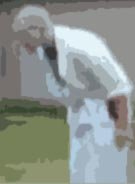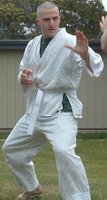bowing- an afterthought

having been raised in a western culture it is difficult for me to understand the complex etiquette surrounding this most simplistic of gestures. A bow. When should we bow? How should we do it?
more than a handshake
sensei Rex explained that we should always bow to our training partners before beginning an exercise as a sign of respect and at the end to thank them. We did a special kind of bow at the beginning and end of class. The act of bowing can be a way of saying hello, goodbye, thank you, I'm sorry, I respect you, I admire you, et cetera.
if someone bows to you and you don't bow back, it is as if someone extended their hand and you just looked at them. It is very rude. You should always bow based on a few simple contextual points--
status
are you bowing to a peer? A teacher? An important visitor? These factors should be considered carefully to render respect
activity
are you walking down the street? Seeing someone in the halls? About to begin a training exercise? Participating in a ceremony? Are you a guest in someone's home?
motivation
do you want to simply say "hi?" are you wanting to keep an interaction formal or informal? Do you want to insult someone? Are you the teacher and they the student?
nod vs mopping the floor: the extremes of social graces
once you have taken into account your social circumstances it is time to execute a proper bow.
the nod
perhaps the bow that we are most familiar with is the nod. A simple dip of the head as you say good morning to friends or strangers as you pass them in your daily life. Nod in agreement, nod in accepting someone else's counsel, nod when words aren't necessary. Nods are also used when addressing someone inferior to you or who is in a lower station- in other words a teacher or a boss may nod; but the students/employees/servants should remember that he does so as a gesture of good etiquette and not because he is familiar with them.
courtesy to a peer
when bowing to someone equal to you in status it is common to execute a small bow. Males keep hands at sides and bend slightly at the waist. Females keep hands on the front of legs with fingers extended and joined. My teachers have always told me to never take my eyes off of someone I might be fighting, which includes friends and relatives on most occasions. The only people you will probably take your eyes off to bow to are your teacher and the master of your school. Let your eyes relax and take in their whole body as you look in their eyes. Assess them; you may be seconds from a fight and you may need your head in the game.

when addressing teacher
it is considered rude to keep your eyes on those of your instructor unless he or she specifically informs you that they would prefer you to bow eyes locked with theirs. Instead focus on their chest or when addressing a high ranking instructor; their feet. This is because your instructor may test you at any moment and you will need to be able to detect their movements. Your bow should be deep and slow as you are showing respect to them for their station and years of hard work. A common thing to say when bowing to your teacher is "onagai ishi masu" which roughly means "please" and in the teacher/student context can be taken as "please teach me." when completing an exercise (especially with your teacher) it is important to thank him or her and the bow may be accompanied by "domo arigato gozai masu" which roughly means "thank you." if you have impressed your teacher (either by your polite behaviour or your skills) he or she will reply something to the effect of "gokura sama deshita" which means roughly "you trained hard."
when in the presence of greatness
when a visitor comes (or you are visiting someone) of extreme importance it is customary to render a kneeling bow. begin by kneeling on the ground, left leg first, then right leg. Settle back on your heels and cross your toes (if not wearing shoes) right over left. Then place your left hand (fingers pointing slightly inward) to the left of your center and on the ground, then your right hand in the same fashion so that it forms a triangle in front of you. Bow low and slow, touch your forehead to the ground in between your hands. This is considered the highest form of respect in bowing and is reserved for very important people and ceremony.
some points to remember
who-you are bowing to
why-you are bowing to them
what-is the message you want to transmit to them
how- to respond properly when someone bows to you

0 Comments:
Post a Comment
<< Home